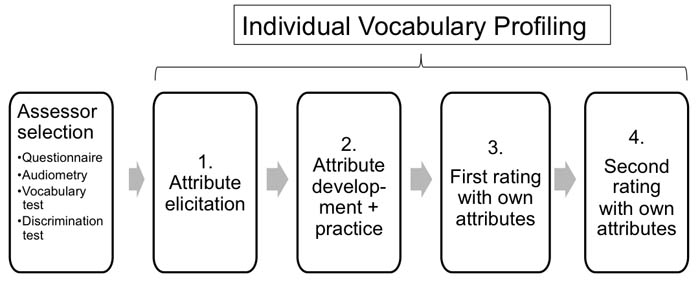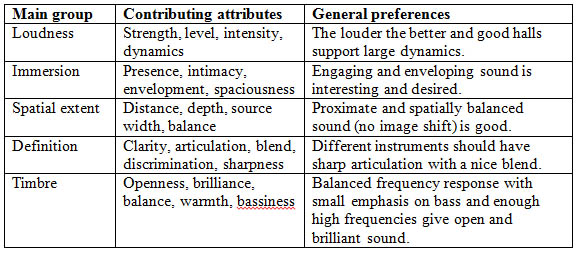
Tapio Lokki – Tapio.Lokki@aalto.fi
Aalto University
Department of Media Technology
P.O.Box 15500
FI-00076 AALTO
FINLAND
Popular version of paper 4aID1
Presented Thursday morning, June 6, 2013
ICA 2013 Montreal
Concert hall acoustics have been investigated for over 100 years. Since the pioneering work of Sabine (1900), scientists have tried to understand why some halls sound better than others and what perceptual attributes contribute to the general opinion of extraordinary acoustics. However, subjective and objective comparison of concert halls (Beranek, 2004) is not an easy task since preferred acoustics depend on a number of elements. The music, the conductor, and the performance of the orchestra greatly affect the listening experience, and the contribution of the auditorium acoustics are hard to isolate with subjective surveys.
The ambivalent interpretation of questionnaire responses from musicians and public audiences as well as the methodological challenges of traditional listening tests in the laboratories made us rethink the whole subjective evaluation process. Finally, we borrowed a sensory evaluation methodology from the food and wine industry (Lawless and Heymann, 1999), as wine tasting shares similar problems with acoustics, such as multidimensional perceptual attributes and matters of personal taste.
SENSORY EVALUATION
Sensory evaluation can be performed using consensus vocabulary profiling (CVP) where a group of assessors first elicit the adjectives to describe the stimuli and then with group discussions develop a common vocabulary of consensus attributes. However, more suitable methodology for concert hall acoustics studies is based on individual vocabulary profiling (IVP), which allows the assessors to employ their own attributes, and thus overcomes the need for assessors to interpret the complex meanings of consensus attributes used in CVP. For example, the attribute clarity can have several definitions and it cannot be ensured that all assessors would understand and agree upon the meaning and usage of such an attribute scale.
The IVP process applied in concert hall acoustics research is illustrated in Fig. 1 Kuusinen et al. (2010). It consists of four phases, starting with careful listening of samples and attribute elicitation. Finally, the most prominent attributes are selected for each assessor and they perform the actual rating of the samples twice so that the reliability of the assessor can be tested afterwards (Lokki et al., 2011b).

FIGURE 1: The IVP process for each assessor. The whole process requires 3-4 sessions of two hours with about 20 assessors.
CREATING STIMULI FOR IVP STUDIES ON CONCERT HALL ACOUSTICS
The IVP process requires that assessors should be able to switch between different acoustics, i.e., seats or concert halls in the blink of an eye. This requires recordings of symphony music played with the same orchestra exactly at the same level and tempo in each hall. Even a professional orchestra cannot do this as the players intuitively adjust their playing style according to the acoustics. Therefore, to capture the sound of exactly the same symphony orchestra we have invented a system called a loudspeaker orchestra (Pätynen, 2011). It consists of 34 calibrated loudspeakers that are distributed on the stage in the form of a real orchestra as illustrated in Fig. 2. The music reproduced with the loudspeakers is recorded one player at a time in an anechoic chamber (Pätynen et al., 2008). This "symphony orchestra simulator" has been found very useful and the authenticity of reproduced sound with multichannel setup in the laboratory is high.

FIGURE 2: The loudspeaker orchestra (left) and the microphone array (right) used to capture spatial impulse responses or spatial sound.
For reproducing the spatial sound in the hall at the laboratory, high quality spatial audio recording and reproduction techniques are developed (Tervo et al., 2013). Recordings at different seats are made with multi-microphone techniques, e.g., an array consisting of six omnidirectional microphones in a 3D setup (see Fig. 2). Such a microphone array allows capturing of music to be authentically reproduced with a 3D multichannel setup in the laboratory
RESULTS
The sensory evaluation methodology works remarkably well for assessing subjective differences in acoustics between concert halls and between seats in one hall. First, the evaluation process produces a list of effective perceptual characteristics to identify salient perceptual attributes between the studied halls. Second, ratings with individual attributes can be clustered and sensory profiles of studied concert halls can be formed. Third, the ordination of concert halls is revealed according to the attribute clusters. If the preference rating is included in the listening test, the preferences could be explained with sensory profiles of halls.
The main findings of our studies (Lokki et al., 2011a and 2012) are listed in the following table:

Moreover, the preference judgments were divided into two groups of assessors, the first preferring concert halls with loud, enveloping and reverberant sound. The second group preferred concert halls that render intimate and close sound with high definition and clear sound. All assessors did not prefer the concert halls with weak and distant sound.
CONCLUSIONS
The acoustics of a concert hall are heavily a matter of taste. Therefore, sensory evaluation methods are very useful for studying auditorium acoustics due to their ability to extract information often hidden behind preference judgments. With such methods the sensory profiles of concert halls or profiles of seats inside one concert hall can be formed. On the other hand, in the affective domain preference judgments might give an overall average picture, but the variance in the data is typically large due to the differences in personal taste and previous experiences of the assessors. Sensory evaluation methods provide a link between these domains, enabling profiling of the halls with perceptual characteristics. Such profiles are useful to interpret physical measurement data and can help to explain the preference ratings.
REFERENCES
Beranek, L. (2004). Concert Halls and Opera Houses: Music, Acoustics, and Architecture, 2nd edition (Springer-Verlag (New York)).
Kuusinen, A., Vertanen, H., and Lokki, T. (2010). “Assessor selection and behavior in individual vocabulary profiling of concert hall acoustics”, in AES 38th International Conference on Sound Quality Evaluation, 181–190 (Piteå, Sweden).
Lawless, H. and Heymann, H. (1999). Sensory evaluation of food: principles and practices (Aspen Publishers, New York, NY, USA).
Lokki, T., Pätynen, J., Kuusinen, A., Vertanen, H., and Tervo, S. (2011a). “Concert hall acoustics assessment with individually elicited attributes”, Journal of the Acoustical Society of America 130, 835–849.
Lokki, T., Pätynen, J., and Zacharov, N. (2011b). “Concert hall acoustics assessment with sensory evaluation – tools and practices”, in The IOA 8th International Conference on Auditorium Acoustics, 35–44 (Dublin, Ireland).
Lokki, T., Pätynen, J., Kuusinen, A., and Tervo, S. (2012). “Disentangling preference ratings of concert hall acoustics using subjective sensory profiles”, Journal of the Acoustical Society of America 132 , 3148-3161.
Pätynen, J. (2011). “A virtual symphony orchestra for studies on concert hall acoustics”, Ph.D. thesis, Aalto University School of Science.
Pätynen, J., Pulkki, V., and Lokki, T. (2008). “Anechoic recording system for symphony orchestra”, Acta Acustica united with Acustica 94 856–865.
Sabine, W. (1900). “Reverberation: Introduction”, The American Architect.
Tervo, S., Pätynen, J., Kuusinen, A., and Lokki, T. (2013). “Spatial decomposition method for room impulse responses”, Journal of the Audio Engineering Society 61, 16-27.